Social media is becoming big business, as proved by these statistics quoted by Shaun Austin, associate director in the YouGov media team: “There is speculation that Twitter is currently raising funding which values the microblogging site at $7 billion, while LinkedIn shares more than doubled following its launch on the New York Stock Exchange.”
To understand what is driving the success of these social networking sites and how PR companies can leverage them, YouGov analysed data from its social media tracker to investigate who is using them, how and why.
Figure 1 - Percentage of UK population who have an account and/or use each social network site
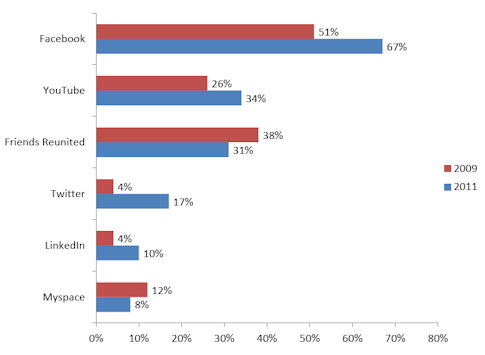
Research supplied by YouGov
In 2011, 67 per cent of the GB online population have an account on Facebook, up 16 per cent from 2009, making it far and away the most popular social networking site. Austin describes the rise and fall of popularity of other key sites: “YouTube, Twitter and LinkedIn are all showing an upward trend since 2009. Friends Reunited and Myspace show a decline in those using each site, however 31 per cent of the British online population still has an account with Friends Reunited – although 80 per cent of these check their account less frequently than once every two weeks.”
Austin says that much of Facebook’s success stems from appealing to older people, with the biggest growth coming from the 35-plus age cohorts, particularly those aged over 55. While Twitter still has a long way to go in terms of generating mass market appeal, much of its growth continues to stem from the younger early adopters.
Figure 2 – The demographic profile of site users and how it’s changed since 2009
Facebook user profile: 2009 - 2011:
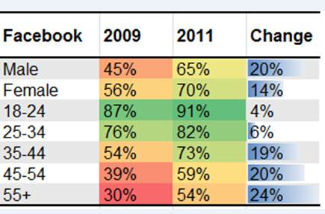
Twitter user profile: 2009 - 2011:
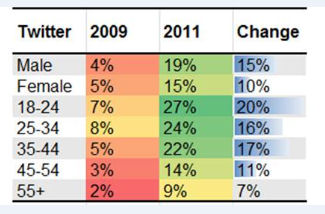
YouTube user profile: 2009 - 2011:
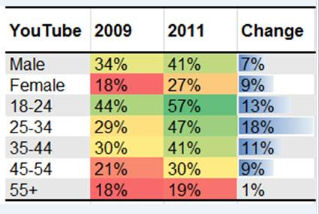
Research supplied by YouGov
Discussing which site is the best for launching a PR campaign, Austin says that in terms of reach, Facebook is the most popular site and has the broadest appeal among different age groups: “Over 90 per cent of 18 to 24 year olds have an account on Facebook, but crucially, over half of those aged over 55 years old also have an account on Facebook. Facebook is also clearly the most engaging social networking site, with users visiting the site 1.7 times per day on average, more than any other site, with the closest rival being Twitter (1.2 times per day on average).”
Highlighting how engaging Facebook is, Austin points out that among 18 to 24 year olds, the average number of visits per day is 2.6. He adds that Facebook also has the longest average time spent on site per visit – 33 minutes, longer than YouTube (25 mins) and Twitter (21 mins), which means any PR efforts are more likely to be noticed.
Discussing Twitter, Austin says that although its popularity has grown significantly in the last couple of years, it still lacks a mass market penetration. About a quarter of the UK’s online 18 to 34 year olds have an account on Twitter, but among those aged over 45 years old usage is significantly lower – around 11 per cent. Austin adds that although recent news stories such as the leaking of information about Ryan Giggs’ affair has increased awareness of the site, it appears that more needs to be done to engage the older age groups.
Focusing on LinkedIn, although this has seen some growth in the last couple of years, it is still a niche social networking site, with 10 per cent of the online population saying they have an account. It has a gender bias, being used by 13 per cent of men compared to 7 per cent of women and is also more biased towards ABC1s with 15 per cent of these having an account compared to just 4 per cent of C2DEs.
In conclusion, Austin says that as well as having different demographic profiles, all sites perform different functions and this should be taken into account when launching a PR campaign on social networking sites: “Campaigns must be relevant and highly targeted to site-user profiles, purposeful in terms of tone, style and content and ultimately, must engage or enhance rather than disrupt the social networking experience.
Figure 3 – main function by social media site:
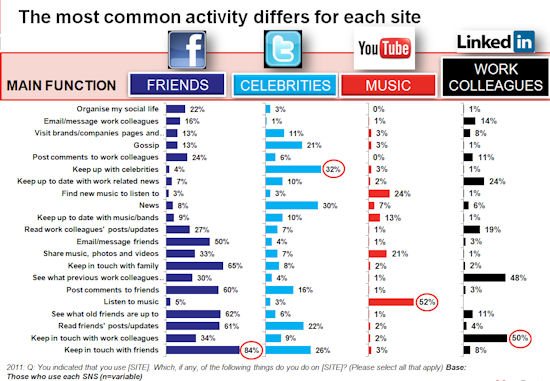
Background
All figures, unless otherwise stated are from YouGov (www.yougov.com). Total sample size was 2,723 nationally representative GB respondents. Fieldwork was undertaken between the 28 January and 2 February 2011. The survey was carried out online.
PR Masterclass: The Intersection of PR and GEO
Join PRmoment for a Masterclass featuring 10 of the industry’s foremost experts. You will walk away with a clear, actionable strategy for adapting your content to an AI-first search environment.
Taking place on Wednesday 25th February in London, both virtual and in person tickets are available.
Early bird ticket sale ends Friday 9 January.
PR MasterclassIf you enjoyed this article, sign up for free to our twice weekly editorial alert.
We have six email alerts in total - covering ESG, internal comms, PR jobs and events. Enter your email address below to find out more:









